Pendo vs Chameleon: Which is Better for Customer Feedback?
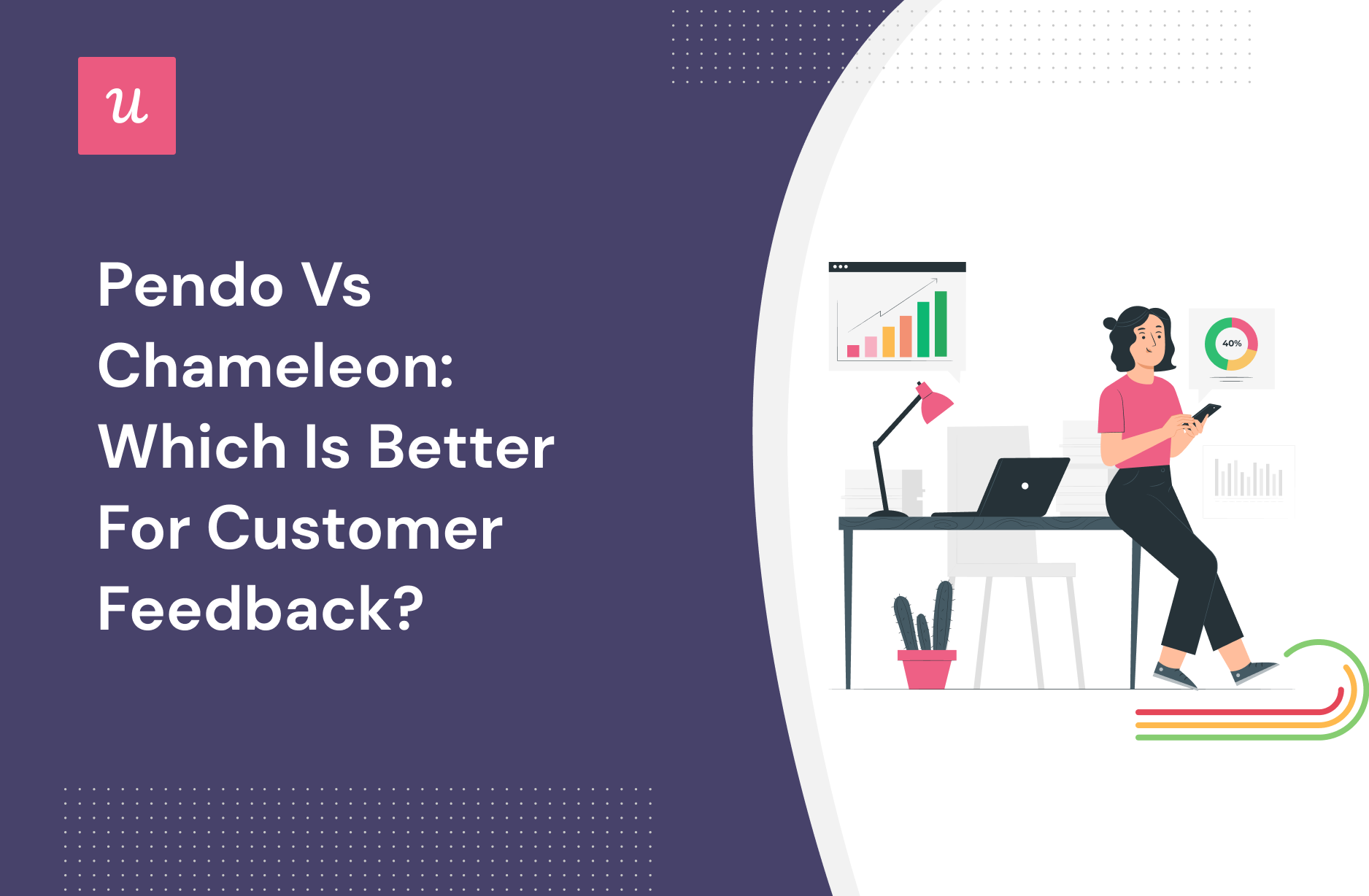
What is the best customer feedback tool, Pendo or Chameleon? And is there a better in-app feedback software that would better fit your needs?
There are so many options on review sites that it’s difficult to pick just one.
The process of choosing a suitable tool becomes even more challenging when you also take into consideration your priorities, feature needs, and budget.
In this article, we will compare the top solutions for collecting customer feedback, enabling you to make an informed decision quickly and easily.
Let’s get started!
TL;DR
- Customer feedback refers to the information and opinions your customers share about your product.
- Customer feedback reveals areas for improvement and allows you to make data-informed decisions that change customer experience for the better.
-
Using tools, you can automate feedback collection and analysis, and ensure the right data is collected from the right people.
-
A great tool should support multiple types of micro surveys, such as NPS, CSAT, CES, etc. Additionally, it should be customizable, support feedback analytics and response monitoring, as well as integrate with popular third-party tools.
-
Pendo offers impressive analytics, in-app feedback, and product adoption features – all in one place.
- You can collect feedback through Pendo’s guides using polls (also called micro surveys at Userpilot). There is not much customization available with polls, like themes and emojis, which is a major drawback compared to other tools.
-
If you want to collect user sentiment using NPS surveys, you’ll need a paid plan, which is quite costly. Even with a paid plan, the NPS capabilities are still limited. For example, you can’t create user segments based on NPS scores and use insights to personalize the user experience.
- Chameleon is a powerful tool for collecting user feedback. It allows you to create multiple types of surveys, set the triggering frequency, and get access to basic completion reports.
-
There are two major drawbacks to Chameleon. First, it isn’t truly a no-code tool: you will either need CSS knowledge or a developer’s help to customize the surveys created with it. And second – it doesn’t have advanced analytics functionalities as many other tools, including Pendo does.
- If neither Pendo nor Chameleon is what you expected, consider Userpilot – a better alternative both in terms of money and value. Userpilot offers the best of both worlds – easy setup of the in-app customer feedback surveys, full customizability, and in-app analytics options, and yet – it’s perfectly affordable with plans starting at $249 per month!
- Userpilot empowers you to create multiple types of in-app micro surveys including PMF, CES, CSAT, NPS, fully customize the survey’s look and feel, embed long-form surveys using Typeform, and of course, decide who gets which survey with advanced segmentation.
- And that’s not all, with Userpilot you can also create sophisticated segments based on survey answers and deliver each customer a customized experience according to their needs.
- From Pendo vs Chameleon, Userpilot is the best choice for customer feedback.
![]()
Looking for the best tool for customer feedback? Search no more!

What is customer feedback?
Customer feedback is any information provided by customers about their experience with a product or service. By analyzing customer feedback, you can reveal their level of satisfaction and pinpoint areas for improvement.
Why should you care about customer feedback?
Customer feedback is important if you want to truly serve your customers and come up with solutions that can solve their pain points.
Here is why customer feedback matters:
- Understand whether customers see value in your product and if it meets their needs
- Uncover weak spots of your product and bottlenecks that disturb the customer journey
- Make your customers voices heard and acknowledge them that they are important to you
- Collect real-time insights on the go as you’re introducing new features or product updates
Why do you need tools for customer feedback?
Wondering why you even need a customer feedback tool? There are several reasons why you may need one:
Collecting customer feedback should be a standard procedure for any product team.It should be consistent and gained across different stages of the customer journey so you can measure customer experience in different situations. This might be time-consuming but thanks to customer feedback tools, the process can be hassle-free and literally without any coding.
Here’s how customer feedback tools help.
- Create different forms of microsurveys, such as NPS, CSAT, CES, PMF to collect contextual feedback
- Customize the surveys so they are aligned with your brand and match the interface of your app
- Segment customers by their feedback so you can create personalized flows for them
- Conduct a user sentiment analysis to understand your customers better
Now you might ask yourself, how to choose the right customer feedback tool for your SaaS? This is what we will be discussing next.
What are the must-have features of a customer feedback tool?
Before deciding which customer feedback tool works best, you should understand what features any solid tool must provide.
Here’s what to look for before making a buying decision:
- Make sure the tool you choose supports multiple forms of microsurveys. The most important and popular ones for collecting customer feedback include the Net Promoter Score, Customer satisfaction score, Customer effort score, product-market fit survey, etc
- You should also get customization capabilities so that the surveys you create match your interface and don’t look odd. No tool branding is also preferable
- Feedback analytics and response monitoring are the next key features if you want to not only collect feedback but also analyze it and understand the intent behind your customers’ scores.
- Integration with 3rd party survey and analytics tools so you can enrich your surveys to make the most out of the customer feedback
There you have it. These are the basic features you should be looking for, but the tool you should go with must be dependent on your specific goals. You might need a tool that must cover all of these features but if you don’t need complex features, you should be completely ok with a tool with limited functionalities.
Pendo for customer feedback
Pendo is a comprehensive digital adoption platform with impressive analytics, in-app feedback, and product adoption features
It caters primarily to enterprise users and probably has the most advanced analytics of all tools we’re covering in this article. But it all comes at a price.
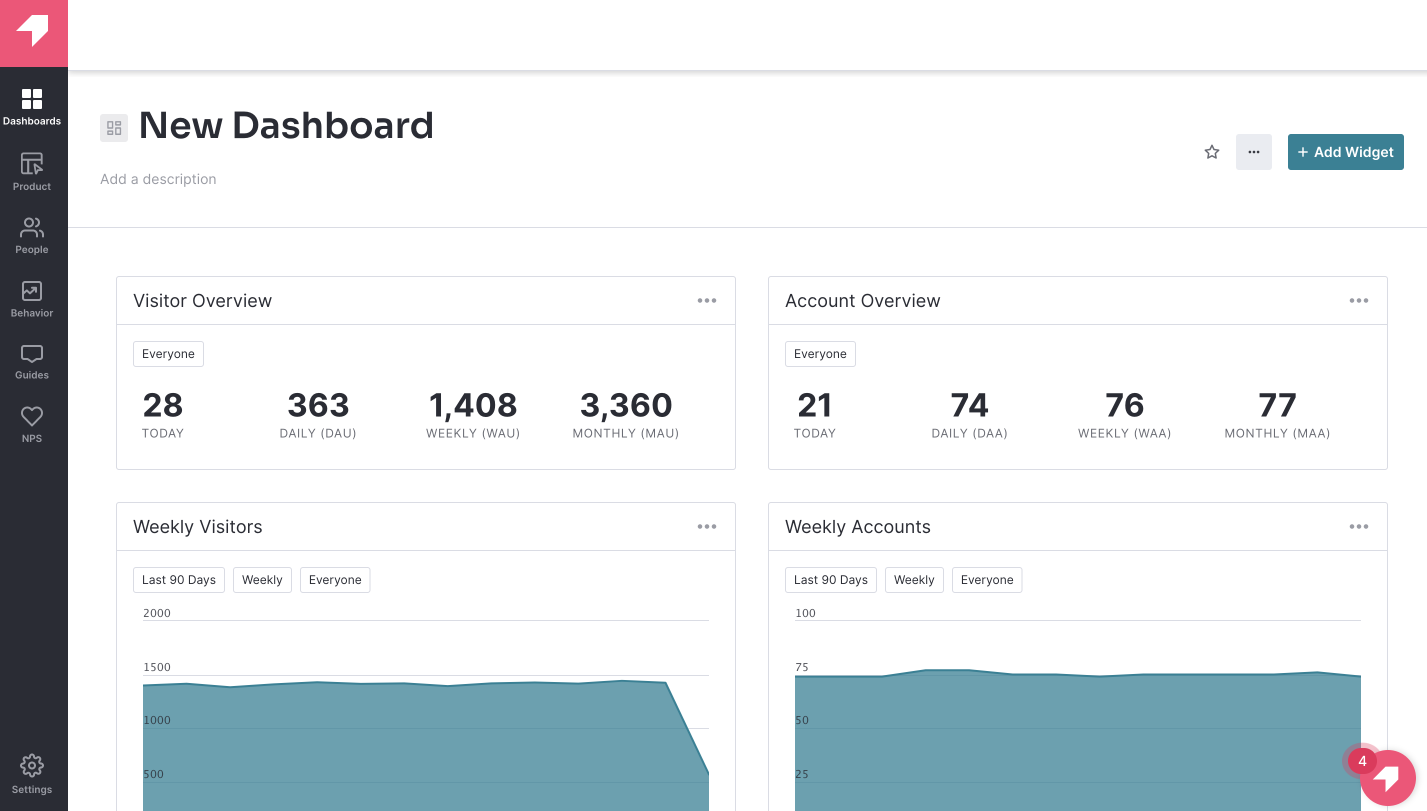
Pendo offers polls (also called micro surveys at Userpilot) through their guides which collect user feedback and gauge sentiment at different points in the user journey.
Polls come with basic functionality and are available on the free plan. However, if you want to collect user sentiment with NPS surveys, you’ll need a paid plan that doesn’t come cheap at all.
Here’s how you can collect user sentiment feedback with Pendo:
- Add short polls on your guides and UI patterns built with Pendo.
- You can use only text polls, yes/no polls, numbered scales, or multi-choice polls and add them as building blocks when building the guides.
- There’s not a lot of customization, like themes or emojis available, but it’s enough to collect data in-app.
- If you are willing to pay for the Growth plan, you get access to Pendo’s NPS feature too.
The downside of using Pendo for collecting user feedback is that you can’t use the insights to personalize the user experience. For example, you can’t create user segments based on NPS scores or specific answers you collect with your polls.
Considering the price you have to pay for Pendo, you’d expect more from it.
If you want to both collect and act on user feedback, you should use a better tool. And, with the risk of sounding biased, Userpilot gives you more value for money here. You can build micro surveys, embed Typeform long surveys, collect and analyze NPS responses, and segment users based on scores and responses so you can trigger more personalized experiences.
Get a Userpilot demo here.
Pros of Pendo?
Despite the price and its steep learning curve, Pendo does have a few pros compared to its competitors.
- Pendo is known for its good and easy-to-use analytics tools like Paths, Retention, and Funnels. (As of Q1 2023, Userpilot will have the same analytics features, with more robust functionality).
- Pendo has a shareable product-planning tool to organize customer feedback and prioritize high-value features. It helps keep teams aligned with the shared feature-planning guide.
- It works on web apps and mobile apps so if you need both, this might be a good choice for you.
Cons of Pendo?
Surprisingly for a product engagement tool that claims to be “all in one” you can’t act directly on the user analytics from Pendo in Pendo.
That’s because Pendo doesn’t allow you to target users segmented by in-app events with the in-app guides you’ve built with it.
Here’s a short list of Pendo’s cons:
- It doesn’t allow you to trigger experiences based on in-app events either. This is probably because of tech debt – but makes Pendo’s analytics pretty much NOT actionable.
- Pendo offers limited onboarding elements, which means you can’t always create the best experience for your users. If you want checklists these can only be accessed from the Resource Center which defeats the purpose of having them in the first place.
- Pendo’s pricing is only available to you if you ask for a quote. The company doesn’t list pricing on its site for the higher tiers. However, some reviews say they have prices starting at $20,000-$25,000 per year for a single product, and around $50,000 per year for the mid-tier package. This might be Pendo’s biggest downside.
If you’re looking for a tool that shows you user analytics in real-time and allows you to trigger in-app experiences based on in-app events and user behavior in real-time – Userpilot offers these features (and at a lower price tag too).
What do users say about Pendo?
Users appreciate Pendo’s analytics but find it complex for building in-app guidance using the guides feature.
As soon as it has been integrated, Pendo is easy to use and manage without the need for developers. I also like that usage is captured retrospectively and the dashboard views or ability to segment users/accounts based on different criteria is really powerful. The guides are great and multi-functional making it really simple for Product Managers to help users navigate with walkthroughs, or post announcements or poll users; they allow Product Managers to get creative with how they engage and interact with users directly in the product. – Parita P.
The best feature about Pendo has been the constant collection of User clicks without the need to set up trackers via code. This enables us to tag the usage directly from the tool and start monitoring historic data without having to involve development teams.- Joseph E.
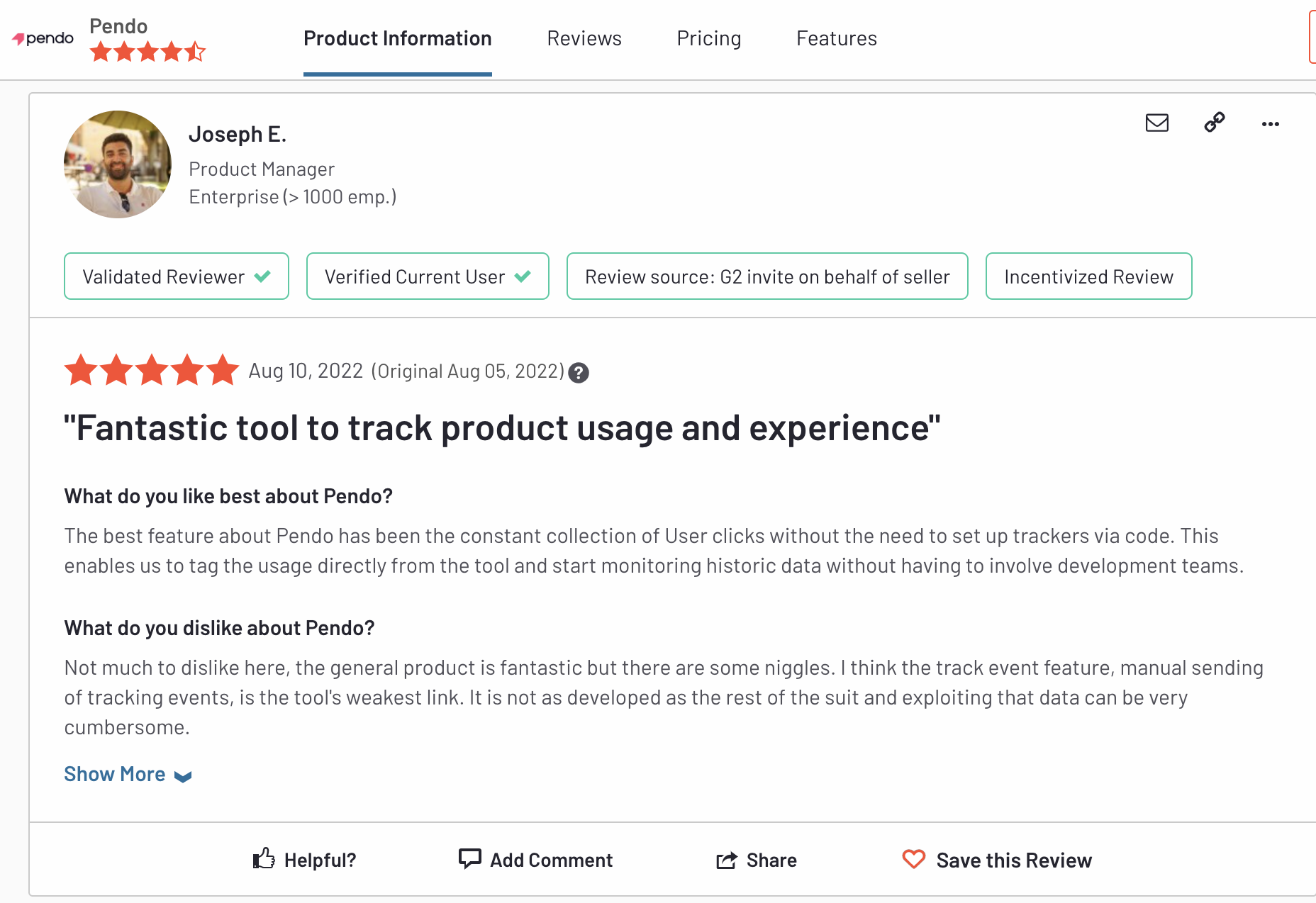
Most users complain about the lack of granularity in analyzing data and the price.
Not much to dislike here, the general product is fantastic but there are some niggles. I think the track event feature, manual sending of tracking events, is the tool’s weakest link. It is not as developed as the rest of the suit and exploiting that data can be very cumbersome.- Joseph E.
And there’s more:
While reports are thorough, a little more granularity would be welcomed. I don’t like that Feedback is a separate cost, as it is a very powerful tool to find out what users want to see in future releases.- Rob S.
And there’s more:
Need to be able to drill more into the Dashboard widgets. For example, using the Stickiness Metrics widget of WAU vs MAU is valuable but I should be able to click into these widgets to figure out which specific Clients these are referring to by different segments. This would be helpful information to hand over to other teams like Customer Success. It would also be helpful to be able to see which Clients are not using certain features when using the Behavior section to create reports. For example, if a CSM has 30 accounts and we can see that 14 are using a specific feature, having a quick list of the 16 not using the fea -Computer Software Admin.
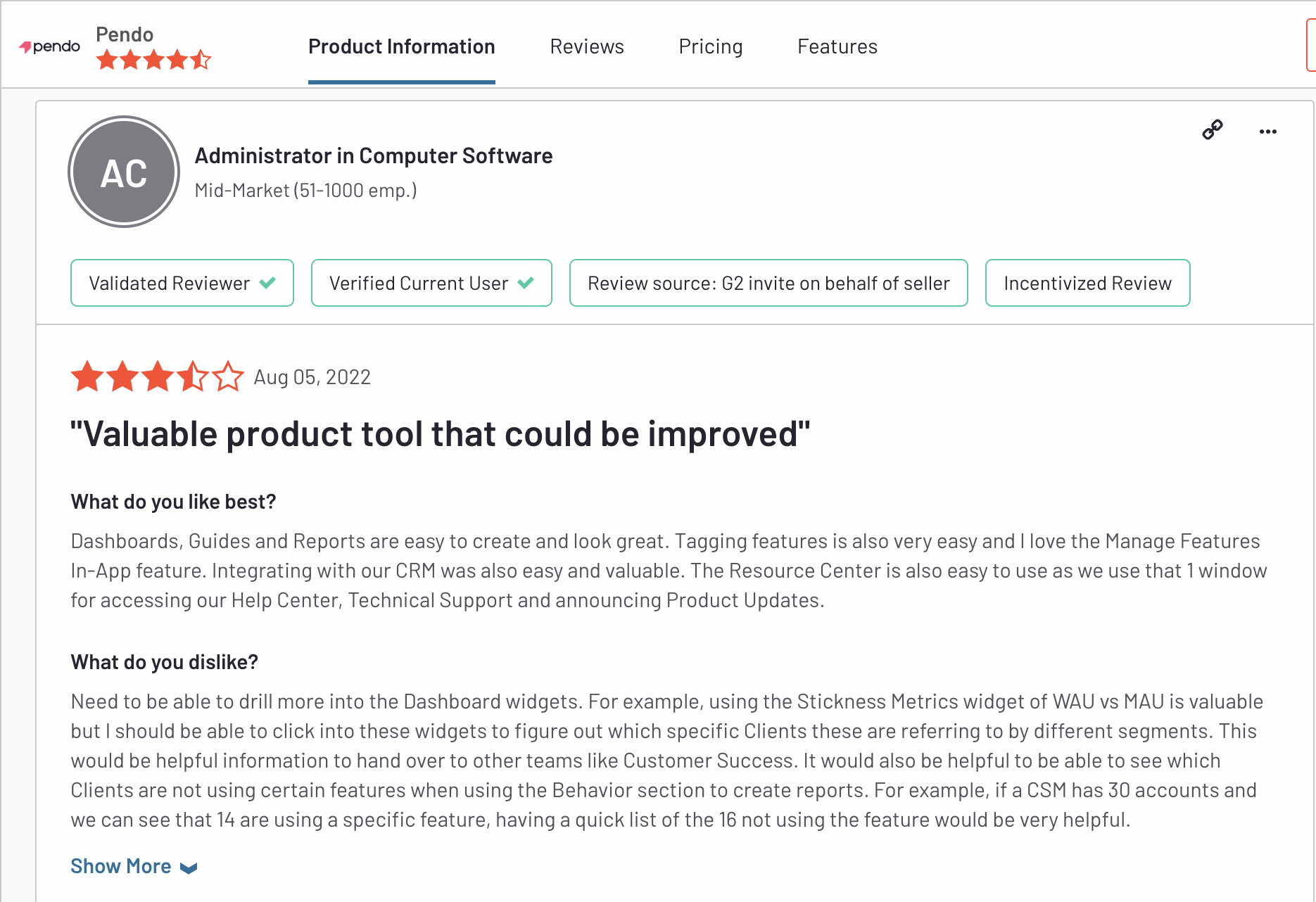
Is Pendo the right fit for your business?
Pendo shines when it comes to analytics, but that’s its main superpower. Here are the top three reasons why you should be looking for an alternative.
- If you only need analytics, there are more affordable tools out there with better functionality too.
- If you want to build more than simple in-app guides and trigger them contextually, Pendo is not the best tool due to its basic guides functionality.
- Not convinced? The price in itself should be the main reason why Pendo is not the best solution.
Pendo pricing
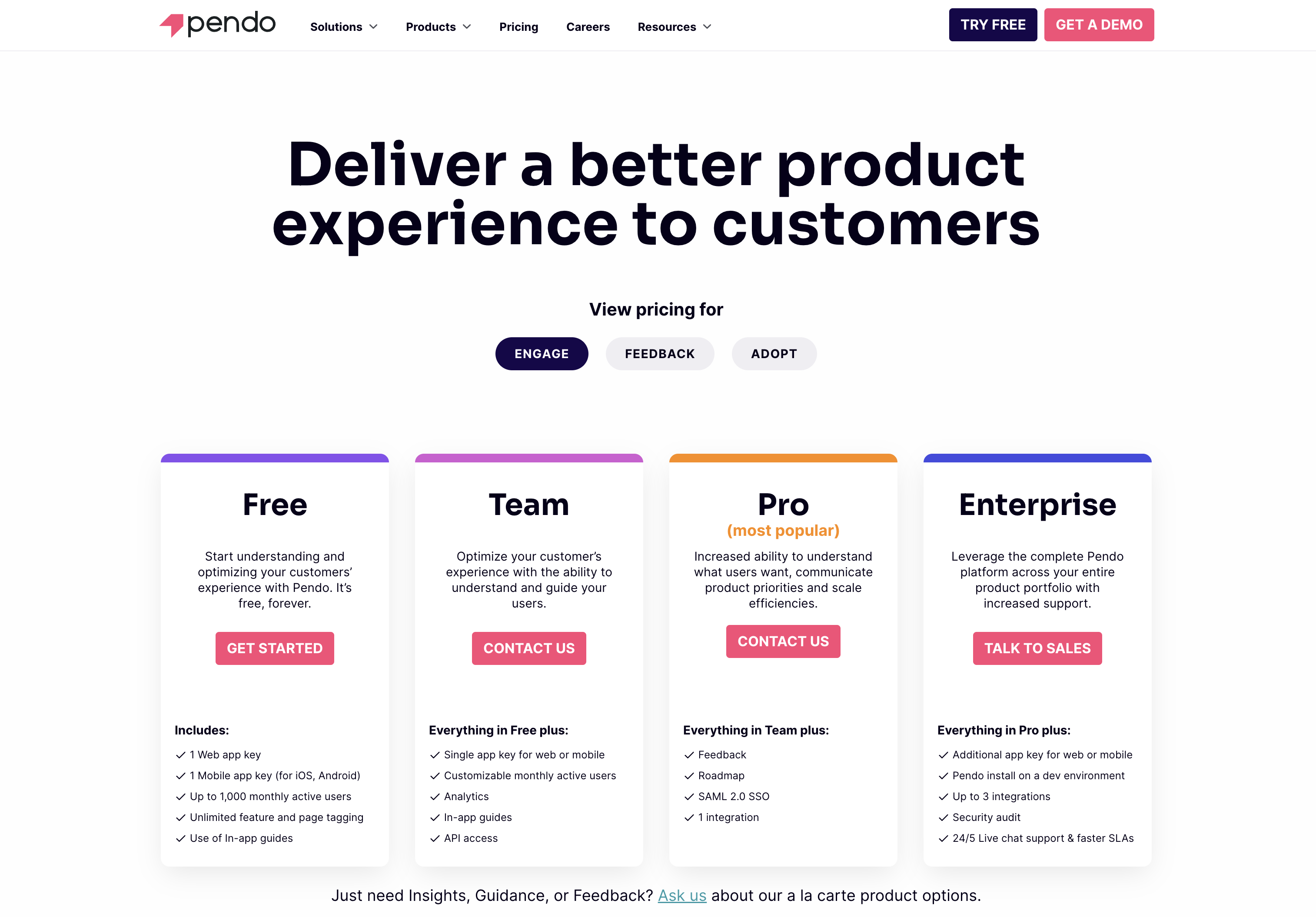
Pendo’s pricing is only available to you if you ask for a quote. The company doesn’t list pricing on its site for the higher tiers. However, some reviews say they have prices starting at $20,000-$25,000 per year for a single product, and around $50,000 per year for the mid-tier package.
The tricky part when it comes to Pendo’s pricing is that you get to pay separately for different modules:
- Pendo Free: up to 500 MAU, single-app, and basic functionality and analytics.
- Pendo Starter $7000/year: 2,000 MAU limit, multi-app, and access to premium features like NPS but it doesn’t include advanced analytics or integrations
- Pendo Growth: Custom MAU, single-app, NPS and PES, resource center, and access to support compared to lower plans
- Pendo Portfolio: Custom MAU, multi-app, cross-journey reports, experimentation, and 1 free integration included.
- Pendo Premium: Custom MAU, multi-app, everything in other plans plus custom roles and permissions and advanced security
- Pendo Feedback: collecting feature requests is a separate module with custom pricing.
- Pendo Adopt: employee onboarding is a separate module with custom pricing
![]()
There is a better tool for your SaaS than Pendo!

Chameleon for customer feedback
Chameleon is a digital adoption platform with a difference: while the other tools discussed are mostly no-code, Chameleon will require some developer involvement.
Nevertheless, it’s a powerful and effective tool that works in a similar way to Userpilot and offers similar features: styling, analytics, templates, goals, A/B testing, and checklists.
However, it doesn’t offer a resource center, or dedicated NPS, and it’s a lot worse value for money with limited features in the basic plan, which is over $150 more expensive for the same number of MAUs.
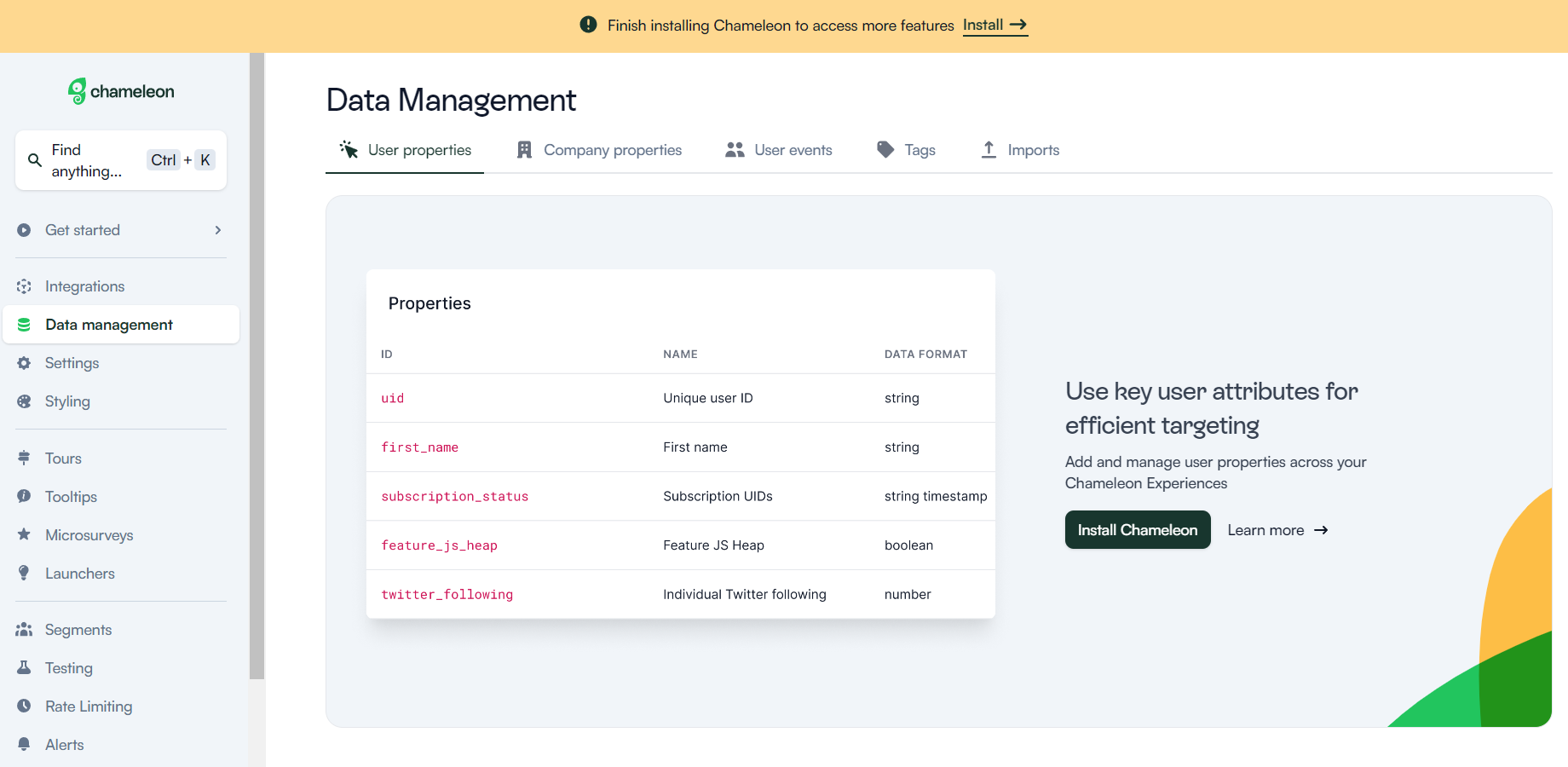
Here’s how you can collect user feedback with Chameleon:
- Build different types of micro surveys (limited to 5 on the Startup plan) such as NPS, CSAT, CES, Opt-in, and custom feedback types.
- Personalize the surveys as you wish (you will need help from a developer or may require CSS skills).
- You can select the survey’s frequency and whether you want it to repeat.
- You get access to basic completion reports. Most of the additional data will need to be analyzed in your analytics tools that Chameleon integrates with and sends data to.
- You will see your NPS score in the reports but for the rest of the micro surveys, you will need analytics tools.
It’s great that Chameleon lets you build beautiful micro surveys but it might not be the best tool if you want to analyze the data and most importantly act on it. For example, with Userpilot you can create custom user segments based on survey responses or NPS scores and trigger specific in-app flows for them.
Pros of Chameleon
Chameleon is a robust tool for your onboarding and adoption needs. Here are the main pros to consider if you’re still deciding:
- Offers a good range of in-app messaging and UI patterns. You can create custom modals, slideouts, tooltips, hotspots, launchers (checklists or resource hub), and more.
- Good segmentation options, you can either build different user segments inside the product, or you can integrate your Chameleon account with other tools and import your data.
- Can be used on 3rd party tools, meaning you can use it for employee onboarding too.
- Offers a good range of two-way integrations: Mixpanel, Segment, Intercom, Customer.io, Segment, Hubspot etc.
Cons of Chameleon
While Chameleon is a great tool, the main downside is the cost and restrictions you get with it. Here are the main cons of the tool:
- There are some limitations to user onboarding flows. You can’t run multiple in-app experiences at the same time, as you can in Userpilot. Instead, Chameleon enables you to create user onboarding campaigns (different sequences of product tours shown over time).
- It’s built for single-page apps: Chameleon can’t build flows that run over multiple URLs.
- Doesn’t offer a self-service resource center where users can access multiple guides and tutorials or contact support. It does provide launchers that are similar but more restricted. A launcher can be a checklist or a list of resources, but can’t be both.
- It has a steeper learning curve and it’s not a completely no-code tool.
- The Startup (starter) plan is quite restrictive and expensive (starts at $349/mo for 2500 MAU and includes 1 Launcher only and 5 micro surveys). You will need to go for Growth ($1249/mo) if you want to drive product adoption.
What do users say about Chameleon?
Users appreciate Chameleon’s versatile functionalities. Let’s see what they have to say about it.
I love the variety of formats we can build in Chameleon, from interactive tooltips to progressive tours and launchers! It’s also really easy to track performance of each of these and adjust accordingly. The interface still feels quite clunky whenever I’m in build mode. For instance, I don’t like that I have to use markdown and CSS when formatting text instead of having an inline styling menu to select from. Then there’s also the issue of surveys or tour steps appearing where they’re not supposed to, apparently mistaking an element in another page for the anchor. -Nikki D
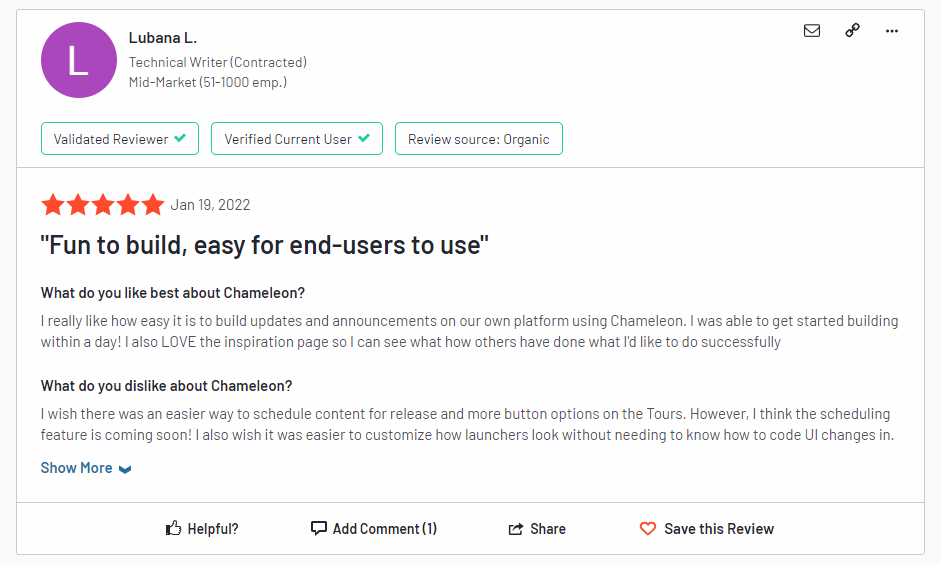
Chameleon is a good tool overall and it’s loved by its users. Most complaints are about the price and some limitations such as customization of tours and reporting and analytics.
I wish there was an easier way to schedule content for release and more button options on the Tours. However, I think the scheduling feature is coming soon! I also wish it was easier to customize how launchers look without needing to know how to code UI changes in. – Lubana L.
There is limited reporting and dashboarding functionality within Chameleon currently. – Administrator in Financial Services
I think the software is a bit on the pricey side, but since it lets us do things that we would normally need our developers to do, we are truly saving in the grand scheme of things. It means we can focus on features and bug fixes, instead of building a new communication method that would only be used internally!-Nathalie L.
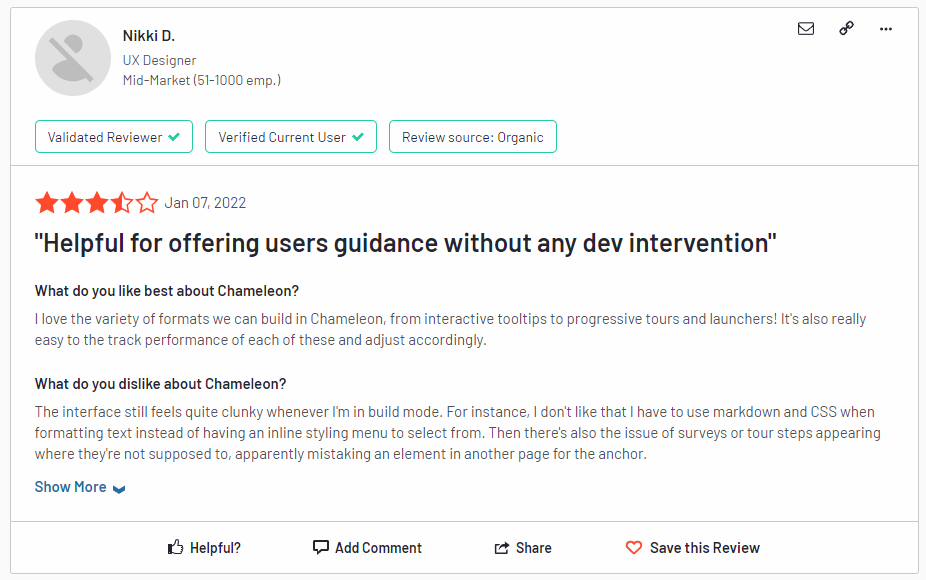
Is Chameleon the right fit for your business?
Chameleon is a great tool but we can’t say it’s the best there is. Here are three main reasons why you might consider an alternative.
- To get access to all the needed tools for proper onboarding and adoption you need to pay for the higher plans that can get expensive.
- Chameleon focuses on customization but in most cases, you will need a lot of CSS to achieve the look and feel of your brand. There are other tools that are truly no-code.
- If you need proper product and user analytics without having to pay for extra tools and integrate with Chameleon, you might need to consider a different tool.
Chameleon pricing
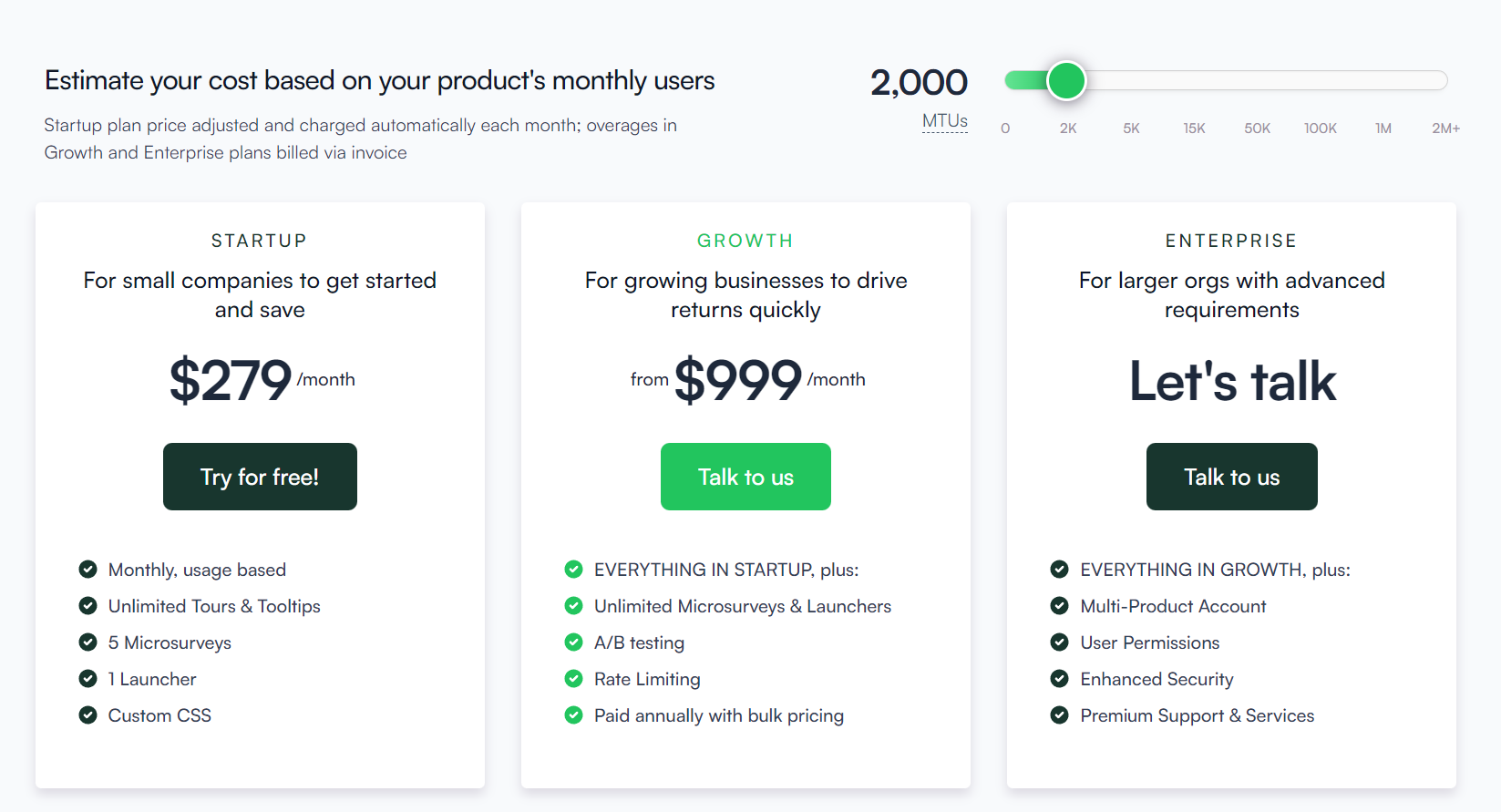
Chameleon split their pricing options primarily by the number of monthly active users, but you should keep in mind that the Startup plan also has limited features and might not be enough for interactive user onboarding and adoption for SaaS products:
- 0 – 2500 MAUs: Startup plan from $349/mo, Growth plan from $1249/mo
- 2000 – 3000MAUs: Startup plan from $419/mo, Growth from $1299/mo.
- 3000 – 5000 MAUs: Startup plan from $489/mo, Growth from $1449/mo.
- 5000 – 10,000 MAUs: Startup plan from $629/mo, Growth from $1749/mo
Disclaimer: with the Startup plan you only get 5 microsurveys and 1 launcher, no A/B testing, no Goals, and no localization.
![]()
There is a better tool for your SaaS than Chameleon!

Is there a better alternative for customer feedback?
Pendo and Chameleon are good tools for customer feedback. We’ve seen how they compare to each other and what you can achieve with them. Call us biased, but if you’re looking for something better, Userpilot offers more value for your money than these tools.
Userpilot for customer feedback
Userpilot is a powerful product adoption platform that enables you to quickly build personalized, flexible, contextually relevant in-app experiences targeted to different user segments – all without writing a line of code.

There are two types of feedback you should be focusing on collecting to better understand the health of your product and users.
First, you have user sentiment which looks at user satisfaction and effort scores or loyalty (using NPS surveys). Then you may also want to collect feedback on the functionality of the product or specific features.
You can do all these with Userpilot. In short, you can:
- Collect and track (NPS) in-app with a built-in NPS widget that allows you to fully customize the survey look and feel, and set the trigger frequency and specific targeting.
- Analyze NPS scores, tag responses, and use the data to create specific user segments.
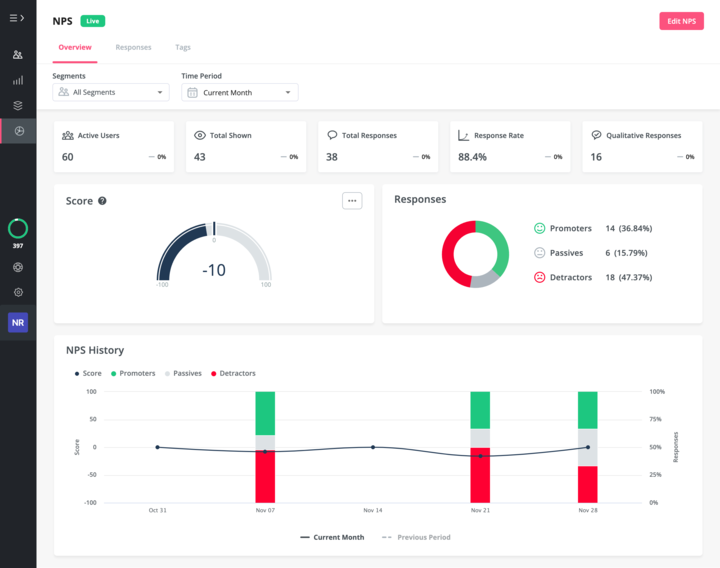
- Build and trigger in-app micro surveys like the classic PMF survey, or similar ones and mix multi-choice and open-ended types of questions to collect specific insights.
- Be in charge of who gets which survey type and when with advanced segmentation capabilities, and of course, you can use the answers to segment your audience.
The advantage of using Userpilot for collecting feedback over other survey tools is that you can better control who sees the surveys but also you can instantly use the data collected to segment your user base and trigger the right experience for them.
For instance, if your users give you a low NPS score because they think you’re missing a critical feature (that you actually have already), you can push an interactive walkthrough guiding them to find and explore this feature.
Pros of Userpilot
Userpilot has a number of advantages, especially for mid-market SaaS companies looking for a robust but at the same time very easy-to-use, no-code tool for user onboarding, product adoption, and simplified product analytics. Let’s have a look at the pros of using Userpilot:
- No-code builder – Userpilot comes with an easy-to-use Chrome Extension builder.
- Multiple UI patterns – choose from a range of options to build customized flows: modals, slideouts, banners, tooltips, hotspots, and checklists are all at your disposal
- UI patterns are not limited by plan – you get access to all of them on every single plan, meaning you get value even with the Traction plan (this is the entry-level one).
- Engaging walkthroughs and onboarding flows- build interactive walkthroughs targeted to distinct user segments.
- In-app help – build a resource center offering self-service support to your users, customize it with your branding, and select from a range of help options to boost user satisfaction (i.e. videos, in-app flows, chat, and more).
- Experimentation – built-in A/B testing for flows lets you explore and quickly iterate based on direct user behavior.
- Powerful feedback options- integrated NPS surveys with analytics and response tagging unlock insight into how your users feel.
- Advanced analytics and segmentation- analyze product usage and in-app flow engagement and build user segments using the data.
- Event tracking and feature tags- tag UI engagement (clicks, form fills, hovers) and group them into one custom event to track what really matters.
- More value with integrations- unlock value faster with built-in integrations with popular tools like Segment, Amplitude, Mixpanel, Kissmetrics, Intercom, Heap, and more.
Cons of Userpilot
Userpilot has a number of advantages, especially for mid-market SaaS companies looking for a robust but at the same time very easy-to-use, no-code tool for user onboarding, product adoption, and simplified product analytics. Let’s have a look at the pros of using Userpilot:
- No-code builder – Userpilot comes with an easy-to-use Chrome Extension builder.
- Multiple UI patterns – choose from a range of options to build customized flows: modals, slideouts, banners, tooltips, hotspots, and checklists are all at your disposal
- UI patterns are not limited by plan – you get access to all of them on every single plan, meaning you get value even with the Traction plan (this is the entry-level one).
- Engaging walkthroughs and onboarding flows- build interactive walkthroughs targeted to distinct user segments.
- In-app help – build a resource center offering self-service support to your users, customize it with your branding, and select from a range of help options to boost user satisfaction (i.e. videos, in-app flows, chat, and more).
- Experimentation – built-in A/B testing for flows lets you explore and quickly iterate based on direct user behavior.
- Powerful feedback options- integrated NPS surveys with analytics and response tagging unlock insight into how your users feel.
- Advanced analytics and segmentation- analyze product usage and in-app flow engagement and build user segments using the data.
- Event tracking and feature tags- tag UI engagement (clicks, form fills, hovers) and group them into one custom event to track what really matters.
- More value with integrations- unlock value faster with built-in integrations with popular tools like Segment, Amplitude, Mixpanel, Kissmetrics, Intercom, Heap, and more.
What users say about Userpilot

Let’s check what real users like about Userpilot.
Userpilot is an incredible, user-friendly software that allows us to create unforgettable experiences for our clients! From basic to complex experiences, we have been able to do them all with ease! I would highly recommend this software to anyone who wants to provide their clients or users with the best product tour experience. The possibilities of what you can create are endless! – Tayla G.
Userpilot is simple to set up, use, and does not require any dev – which means instant publishing. This is critical for us as a SaaS company that releases new features frequently; we need the ability to inform our customers of changes quickly, and doing this in our platform through Userpilot allows us to reach the right audience, at the right time, in the right place. There have been many awesome extra features we’ve discovered since coming on board, and it’s been great to see new features released frequently. The tool itself is intuitive and reliable. Having used similar products previously that were clunky and buggy this has really made us happy with our decision to move to Userpilot. – Melina K.
![]()
Get more value for your money with Userpilot!

Userpilot pricing
Userpilot’s transparent pricing ranges from $249/month on the entry-level end to an Enterprise tier for larger companies.
Furthermore, Userpilot’s entry-level plan includes access to all UI patterns and should include everything that most mid-market SaaS businesses need to get started.

Userpilot has three paid plans to choose from:
- Starter: The entry-level Starter plan starts at $249/month and includes features like segmentation, product analytics, reporting, user engagement, NPS feedback, and customization.
- Growth: The Growth plan starts at $749/month and includes features like resource centers, advanced event-based triggers, unlimited feature tagging, AI-powered content localization, EU hosting options, and a dedicated customer success manager.
- Enterprise: The Enterprise plan uses custom pricing and includes all the features from Starter + Growth plus custom roles/permissions, access to premium integrations, priority support, custom contract, SLA, SAML SSO, activity logs, security audit, and compliance (SOC 2/GDPR).
Conclusion
Now you have all the information you need to make an informed decision between Pendo and Chameleon. Both tools have their advantages and disadvantages, and there is no clear winner. Your choice should depend on your product and current requirements.
If you want the best value for money, going with the alternative option would be our recommendation. Want to see how Userpilot can help with customer feedback? Book a demo below.
![]()
There is a better tool for your SaaS than Pendo!


